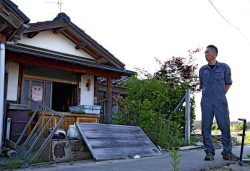Japan Marks 6 Months Since Noto Peninsula Earthquake; Over 4,000 Residents Move Out of Disaster-Hit Areas

Elementary school pupils arrive at Wajima Junior High School in Wajima, Ishikawa Prefecture, on Monday. Students at six elementary schools in the city are temporarily using the junior high school’s facilities.
15:40 JST, July 1, 2024
Monday marked six months since the Noto Peninsula Earthquake struck Ishikawa Prefecture on New Year’s Day. Despite progress in the restoration of roads and water supply systems, and the construction of temporary housing units, many residents continue to leave the disaster-hit areas.
By the end of May, a total of 4,189 people had left the six cities and towns in the prefecture that were most severely affected by the Jan. 1 disaster. This is nearly double the number from the same period last year, when 2,170 people left.
According to population statistics for each municipality, 1,257 people left Wajima from January to May, compared to 531 in the same period last year. Suzu saw 567 leave, compared to 164 last year, and Noto had 428 people leave, against 223 last year.
Anamizu had 292 people leave, up from 100; Nanao saw 1,240 go, compared to 858 last year; and Shika saw 405 people leave, up from 294.
According to the Ishikawa prefectural government, 281 people in the prefecture have died as a result of the earthquake, surpassing the 276 people who died in the 2016 Kumamoto Earthquake.
A total of 229 people died of causes directly triggered by the Noto disaster, such as being trapped in collapsed buildings, caught in fires or tsunami. As of Thursday, the remaining 52 deaths were recognized as disaster-related, including people who died because a chronic illness worsened while they were staying in evacuation centers.
As of Friday, applications for disaster-related deaths had been made for 221 people, including cases already certified by the local governments. The prefectural and municipal governments in the affected areas have been working with expert panels to review the applications since May.
More than 2,000 people still live as evacuees, with 970 staying in primary evacuation centers, and 1,222 in secondary evacuation sites, such as hotels and other accommodations.
Construction of temporary housing units is expected to be completed in August.
While progress has been made in restoring roads and water supply systems, the demolition of damaged houses and other buildings has not gone smoothly, mainly due to a lack of construction workers. Only 4.7% of the total applications for demolition by local governments at public expense had been completed as of Friday.
The Environment Ministry has begun to provide subsidies to municipal governments when they hire contractors from distant locations to help speed up the demolition work.
Many parts of the disaster-stricken areas still look much the same as they did immediately after the earthquake, leaving many residents uncertain about how to rebuild their lives.
"Society" POPULAR ARTICLE
-

M4.9 Earthquake Hits Tokyo, Neighboring Prefectures
-

M7.5 Earthquake Hits Northern Japan; Tsunami Waves Observed in Hokkaido, Aomori and Iwate Prefectures
-

Israeli Tourists Refused Accommodation at Hotel in Japan’s Nagano Pref., Prompting Protest by Israeli Embassy and Probe by Prefecture
-

Tsukiji Market Urges Tourists to Avoid Visiting in Year-End
-

M5.7 Earthquake Hits Japan’s Kumamoto Pref., Measuring Upper 5 Intensity, No Tsunami Expected
JN ACCESS RANKING
-

Keidanren Chairman Yoshinobu Tsutsui Visits Kashiwazaki-Kariwa Nuclear Power Plant; Inspects New Emergency Safety System
-

Imports of Rare Earths from China Facing Delays, May Be Caused by Deterioration of Japan-China Relations
-

University of Tokyo Professor Discusses Japanese Economic Security in Interview Ahead of Forum
-

Japan Pulls out of Vietnam Nuclear Project, Complicating Hanoi’s Power Plans
-

Govt Aims to Expand NISA Program Lineup, Abolish Age Restriction




















